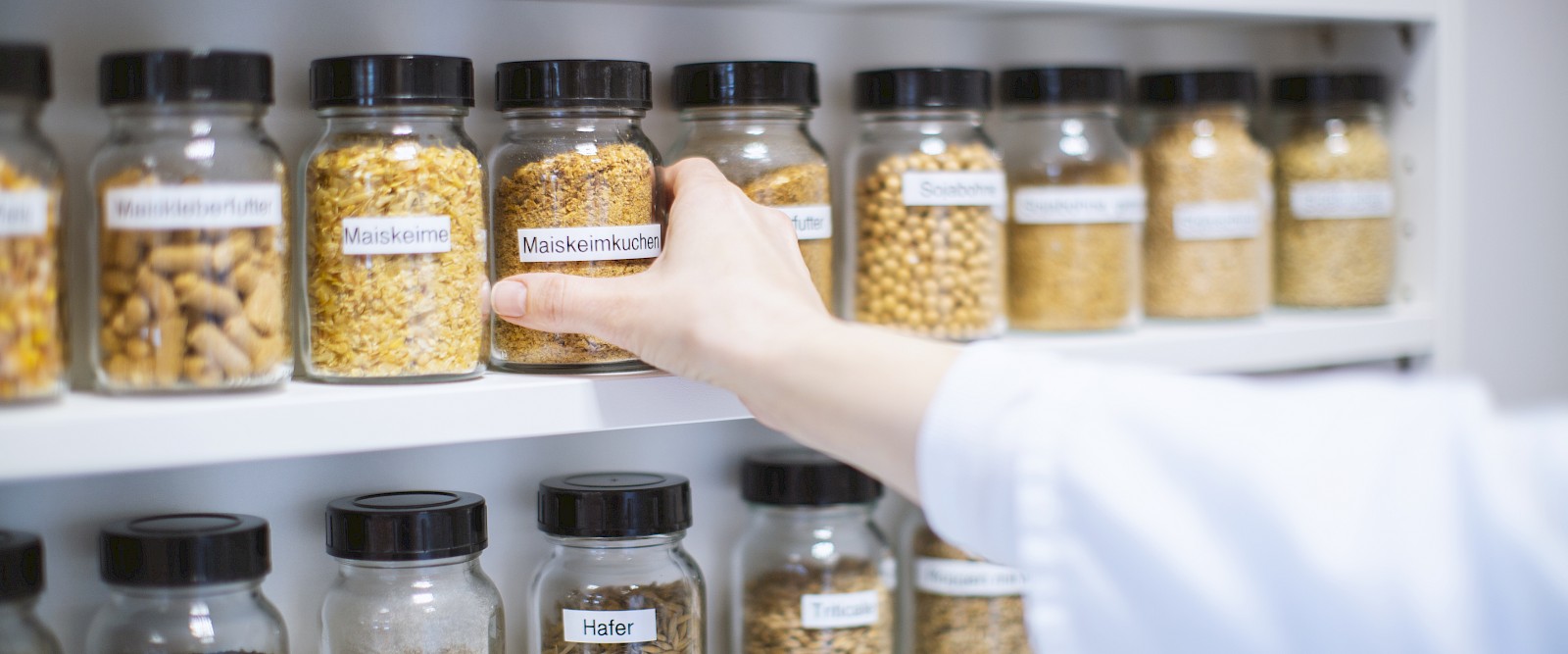Raw material and nutrient lexicon
Lecithin
Lecithin is the name for a mixture of phospholipids. Phospholipids are components of all animal and plant cells. Lecithin is mainly obtained from soybean oil. It accumulates in soy mills as a by-product of edible oil production. It is contained in two to three % of the crude oil. By adding the same amount of water, the lecithin swells to a slimy mass. It can be separated from the oil using centrifuges. The separated yellowish mass is then immediately vacuum-dried. The result is crude lecithin, a fat-like, yellow-brown, viscous substance. While the raw lecithin contains, in addition to the phospholipids, a large number of accompanying substances such as glycolipids, triglycerides, free fatty acids, sterols, saccharides and carotenoids, pure lecithin, which has been largely freed of these accompanying substances by an extraction process, consists essentially of phosphatidylcholine, -ethanolamine, -inositol, phosphatidic acid and glycolipids. Pure lecithin is a yellowish powder or granulate. The main use of lecithin is as an emulsifier and co-emulsifier in the food and feed industry as well as in many areas of the so-called non-food sector.
The orally supplied pure lecithin (consists of the natural substances phosphatidylcholine, -ethanolamine, -inositol, phosphatidic acid and glycolipids) is partly taken over unchanged or as lysolecithin into the intestinal lymph and enters the organism more or less as a total molecule. The other part is split into its components after ingestion and then absorbed. Besides uncleaved lecithin, choline, linoleic acid and phosphate also enter the circulation. Each of these substances has certain vital tasks to fulfil for the function of the organism. The dietary importance is emphasised by the high occurrence of lecithin in metabolically active organs such as the liver, brain, nerves and heart. The enrichment can be explained by the fact that lecithin has an essential function in fat metabolism, i.e. in the transport of all lipid compounds such as cholesterol, glycerides and fatty acids.
Lecithin component of the cell membrane: The cell membrane, which consists mainly of lecithin, has a double-layer structure. The membrane not only separates, but also regulates the exchange of substances, activates enzymes, ensures the influx and outflow of ions and the transmission of nerve stimuli. Approximately 30-40 % of the dry weight of the membranes consists of lecithin. It gives the membranes their fluidity and flexibility. Many diseases or pathological changes in humans are accompanied by a decrease in the mobility of the plasma membrane. This is due to changes in the composition of the membrane lipids or to disturbances in lipid metabolism. The cause can be a shift in the ratio of cholesterol to lecithin in favour of cholesterol or a change in the ratio of unsaturated to saturated fatty acids. Additional lecithin supplements ingested with food are likely to compensate for these membrane changes.
Lipid metabolism disorders: Lecithin plays an important role in fat absorption in the intestine and fat transport in the blood. A balanced lecithin-cholesterol ratio in the blood is necessary to prevent the deposition of cholesterol in the aorta. Since the aorta, unlike the liver, has no excretory mechanism for cholesterol, solubilisation of cholesterol is the only way to remove it from the aorta. Lecithin helps to lower elevated blood cholesterol and blood lipid levels. The linoleic acid of lecithin is indispensable for the transport of cholesterol in the organism. It forms particularly mobile cholesterol fatty acid esters with the cholesterol.
Lecithin and liver: The choline in lecithin plays a special role in the fat metabolism of the liver. It helps to break down excess fat. When the liver is stressed by infections, toxins from harmful germs or prolonged administration of certain medicines, the cell membranes are damaged by lipid peroxidation. In addition to inflammatory symptoms, an excessive accumulation of fat is observed in the liver cells. The persistent fat infiltration in the liver is related to a deficit of lecithin. Fatty acids can only be transported in the form of lipoproteins (HDL, VLDL). An essential component of lipoproteins is lecithin. Therefore, if a sufficient amount of lecithin is not available to the liver, fat is deposited and fatty liver develops. This is an absolute dependence on phosphatidylcholine, the main component of lecithin.
Bile: Bile contains bile acids, cholesterol, pigments and lecithin. While bile acids have an important emulsifying function in fat digestion, cholesterol and bile pigments are superfluous. With the help of lecithin from the liver, micelles are formed from lecithin, bile acids and cholesterol in the aqueous milieu and in this way, the dyes and excess cholesterol that are no longer needed are removed. If disturbances occur in the cholesterol-bile acid-lecithin balance, gallstones form, which usually consist of precipitated cholesterol. Lecithin stabilises the system and thus prevents the precipitation of cholesterol.
Lecithin precursor for acetylcholine synthesis: Brain activity is promoted, among other things, by indispensable substances such as neurotransmitters, which are messenger substances for the transmission of stimuli between brain cells. Of particular importance is acetylcholine, which is formed from choline. It plays a special role in memory storage and the cognitive function of the brain. This acetylcholine-dependent brain region is connected to other brain regions by fibre bundles. If acetylcholine is missing, the ability to store new memory content and the blockage of immediate memory can occur. Neurological diseases that are based on a deficiency of the neurotransmitter acetylcholine can be noticeably improved by additional lecithin from the diet.
Lecithin - energy supplier: Due to the phosphate content in the molecule, lecithin is a potential energy supplier that cannot be overlooked. In the cell, processes are constantly taking place that continuously require certain amounts of energy. The cell's most important energy transmitter is adenosine triphosphate (ATP). ATP is able to transfer phosphate residues to organic compounds, a process called phosphorylation. Using lecithin as a source, ATP can be regenerated with a corresponding phosphate residue while absorbing energy. Muscle contraction, for example, is accompanied by ATP consumption.
Source: Technical information of the American Soybean Association (ASA)






